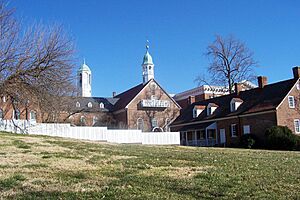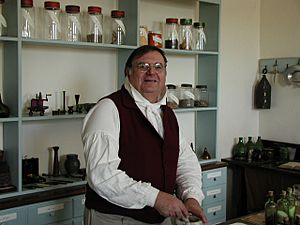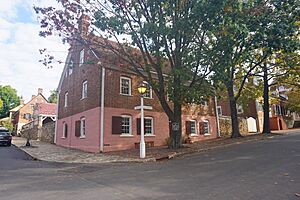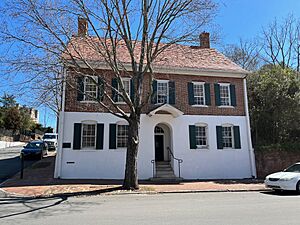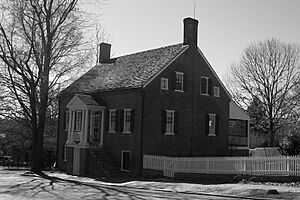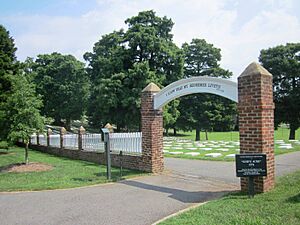Old Salem facts for kids
|
Old Salem Historic District
|
|
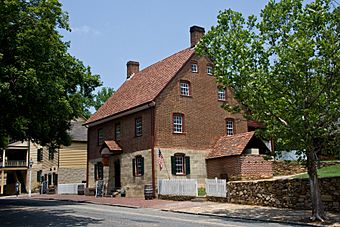
Winkler Bakery at Old Salem
|
|
| Lua error in Module:Location_map at line 420: attempt to index field 'wikibase' (a nil value). | |
| Location | Between Race Street, Old Salem Road, Horse Street and Brookstone Avenue and including parts of God's Acre and buildings along the east side of Church Street, in Winston-Salem, North Carolina |
|---|---|
| Built | 1766 |
| Architectural style | Germanic in early years, slowly shows English/American influence (i.e., Federal and Greek Revival period architecture) |
| NRHP reference No. | 66000591 |
Quick facts for kids Significant dates |
|
| Added to NRHP | November 13, 1966 |
| Designated NHLD | November 13, 1966 |
Old Salem is a special historic area in Winston-Salem, North Carolina. It was first settled by a group called the Moravians in 1766. Today, it's like a living-history museum where you can see what life was like long ago.
A non-profit group started working to restore Old Salem in 1950. Some people had already fixed up buildings before that. The area was named a National Historic Landmark (NHL) in 1966. This means it's a very important historical place in the United States. It was made even bigger fifty years later. Old Salem shows us the culture of the Moravian people. They lived here in the 1700s and 1800s. You can explore their old buildings, churches, homes, and shops.
Two buildings in Old Salem are also famous on their own. These are the Salem Tavern and the Single Brothers' House. Other buildings and areas have been added to the National Register of Historic Places. This helps protect more of the historic area. Different groups own the buildings and land in Old Salem. These include Old Salem, Inc., the Wachovia Historical Society, and private owners. Salem College, Salem Academy, and Salem Congregation also own parts of it.
Contents
Exploring Historic Salem's Beginnings
Salem was founded by members of the Moravian Church. This is a Protestant Christian group that started in 1457. Its first followers were from Bohemia and Moravia, which are now part of the Czech Republic. In 1722, German-speaking Moravians found a safe home. They built a village called Herrnhut on land owned by Count Zinzendorf.
The Moravians first came to North America in 1735. They settled in Savannah, Georgia. Later, in 1740, they moved to Pennsylvania. There, they started towns like Bethlehem and Nazareth. They needed more space for their church communities. So, in 1753, they bought a large area of land in North Carolina. It was about 98,985 acres (400.6 km2). This land was in the Piedmont region of the Province of North Carolina.
Groups from Bethlehem came to North Carolina to start building. They first founded a temporary settlement called Bethabara in 1753. This name means "House of Passage." It was the first planned Moravian community in North Carolina.
How Salem Became a Central Town
Salem was planned to be the main town of a large area called Wachovia. Building started in 1766. Salem was meant to be the center for business, religion, and government. Other Moravian communities nearby were more focused on farming. There were eventually five of these smaller towns.
The church controlled Salem and most of the other communities. The church owned all the property. People could only lease land to build their homes. Everyone in these towns had to be a church member. If someone did not follow the community rules, they could be asked to leave.
The Moravian leaders kept very detailed records. Copies were sent to archives in Bethlehem and Herrnhut. Much of this information has been translated and published. These detailed records helped restore Old Salem accurately. Many original documents are still kept in the Moravian archives.
Salem's Growth and Changes
- In 1849, Forsyth County was created. Salem did not want to be the county's main town. So, it sold land just north of town for a new courthouse. This new town became Winston. Winston quickly grew into a busy industrial city.
- In 1857, the church gave up control of Salem. Residents were then allowed to buy their own property. Salem officially became a town. The town grew bigger twice, in 1889 and 1907.
- Salem and Winston joined together in 1913. They became known as Winston-Salem.
In 1948, a special rule was made to protect Salem's historic buildings. This was one of the first rules like it in North Carolina. In 1950, Old Salem Inc. was created. This group works to save old buildings, restore the town, and run parts of it as a museum.
Old Salem's Museums and Gardens
Old Salem has many restored and rebuilt buildings. People dressed in old clothes work there. They show visitors what Moravian life was like in the 1700s and 1800s. You can see skilled workers like tinsmiths, blacksmiths, and bakers. They practice their trades and talk with visitors. About 70% of the buildings in the historic area are original.
Places to Explore in Old Salem
The center of the village is Salem Square. Salem College is located near the square.
Church Street Highlights
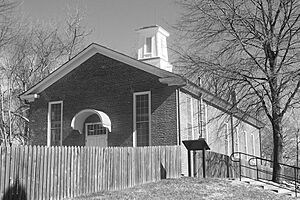
- African Moravian Log Church
- Dr. Samuel Vierling House and Barn (The Doctor's House)
- Home Moravian Church
- Moravian Church Archives
- Salem College
- Single Sisters' House Museum
- St. Philip's Heritage Center
- St. Philip's Moravian Church
Academy Street Highlights
- Boys' School
- Inspectors' House
- Single Brothers' Workshop
Main Street Highlights
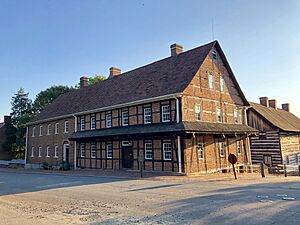
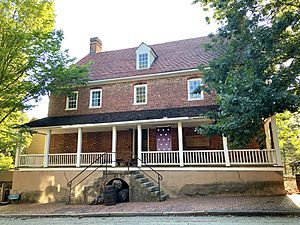
- Augustus T. Zevely Inn
- C. Winkler Bakery
- Community Store
- Dr. John Francis Shaffner House
- Market–Fire Engine House
- Miksch Tobacco Shop
- Salem Tavern
- Salem Tavern Museum
- Shultz Shoemaker Shop
- Single Brothers' House
- Timothy Vogler Gunsmith Shop
- Traugott Bagge Merchant
- Vorsteher's House
West Street Highlights
- Anna Catherina House
- Traugott Bagge House
Salt Street Highlights
- Christman House
- Family Gardens
- Fruit Orchard
- Miksch Gardens
- Christian Triebel Lot Garden
Some famous spots include the Salem Tavern. George Washington stayed there for two nights in 1791. Other popular places are the Single Brothers' House, the Boys' School, and the C. Winkler Bakery. You can also visit many restored homes and shops.
The St. Philip's Moravian Church complex is very important. It is near God's Acre, an old graveyard. In 1823, a 'Negro Church' was built there. This happened after the church decided to have separate worship services. Before this, African-Americans who joined the Moravian church attended Home Moravian Church.
In 1861, St. Philip's Church was built. The Salem congregation built it for the African-Americans in the community. This included both enslaved and free people. It was finished just before the Civil War. It is the oldest surviving African-American church built for this purpose in North Carolina. The Emancipation Proclamation was read to the congregation there in 1865. The church grew and was expanded in the 1890s. The congregation moved to new locations later. But in 2019, they returned to hold services in the brick church. The building was empty from 1952 until it was restored. St. Philip's Church is also listed on the National Register of Historic Places.
Part of the Old Salem historic district includes Salem College and Academy. Their campus has historic buildings like Main Hall and the Single Sisters' House.
Home Moravian Church is still an active church. It welcomes visitors on a regular schedule. Salem Square, in the middle of the district, hosts many special events.
Salem is known as the "Easter City." The traditional Moravian Easter sunrise service has been held every year since 1772. Thousands of people come to Salem Square and the Moravian graveyard for it. In early December, the Candle Tea is held. This event raises money for local charities. It takes place in the Single Brothers' House.
The Market–Fire Engine House was built in 1803. Half of it was a market for fresh meat. The other half stored fire fighting equipment. The town had used this equipment since 1785. That's when the Salem Tavern was destroyed by fire. Salem's fire company is thought to be the first of its kind in North Carolina.
At the north end of the historic district, you can see a large Coffee Pot. It was once a sign for a tin shop. It was moved when Interstate 40 was built nearby.
Visitor Center and Museum
Old Salem's Visitor Center was built in 2003. It's where museum visitors buy tickets. The building has a large area with displays about the history of Wachovia and Salem. It also has food service, gift shops, and an auditorium. The James A. Gray Jr. Auditorium has an old 1800 Tannenberg Organ.
The old visitor center from 1964 was taken down. This allowed for part of the 18th-century Single Brothers' Garden to be rebuilt.
Museum of Early Southern Decorative Arts (MESDA)
The Museum of Early Southern Decorative Arts (MESDA) is part of Old Salem Museums & Gardens. It is in a modern building within the historic district. MESDA focuses on showing and studying old decorative arts from the early South. It opened in 1965.
MESDA was started by Frank L. Horton and his mother, Theodosia “Theo” L. Taliaferro. They were antiques dealers and collectors. They wanted to share their love for objects made in the South. In its galleries, MESDA displays architecture, needlework, and furniture. It also has paintings, textiles, ceramics, and silver. These items were made and used in states like Maryland, Virginia, the Carolinas, Georgia, Kentucky, and Tennessee. Most of the MESDA collection can be seen online.
Notable People from Old Salem
Many interesting people lived in Old Salem. Here are a few:
- Gottfried Aust (1722–1788), a potter
- Rudolph Christ (1750–1833), another potter
- Johann Gottlob Krause (1760–1802), a stonemason
- Elisabeth Oesterlein (1749–1802), an educator
- Melchior Rasp (1715–1785), a stonemason
- Christian Triebl (1714–1798), a carpenter
- Christian Winkler (1766–1839), a baker
The Hidden Town Project
Since December 2016, a lot of research has focused on Salem's African-American population. The Moravians taught enslaved members of their community. They learned to read and write, and some learned trades. This project helps us understand the lives of African-Americans in Salem. It has led to new information being shared at Old Salem. For example, new slave dwellings have been found. Also, the number of enslaved people who lived in Salem from 1790-1860 has been updated.
The goals of this project are:
- To find where enslaved people lived throughout the historic district.
- To study these sites using archaeology.
- To fully share the stories of enslaved people with visitors.
- To connect with the families of enslaved people from Salem. An Advisory Committee helps guide future efforts.
- To share these stories through art and public discussions.
See Also


